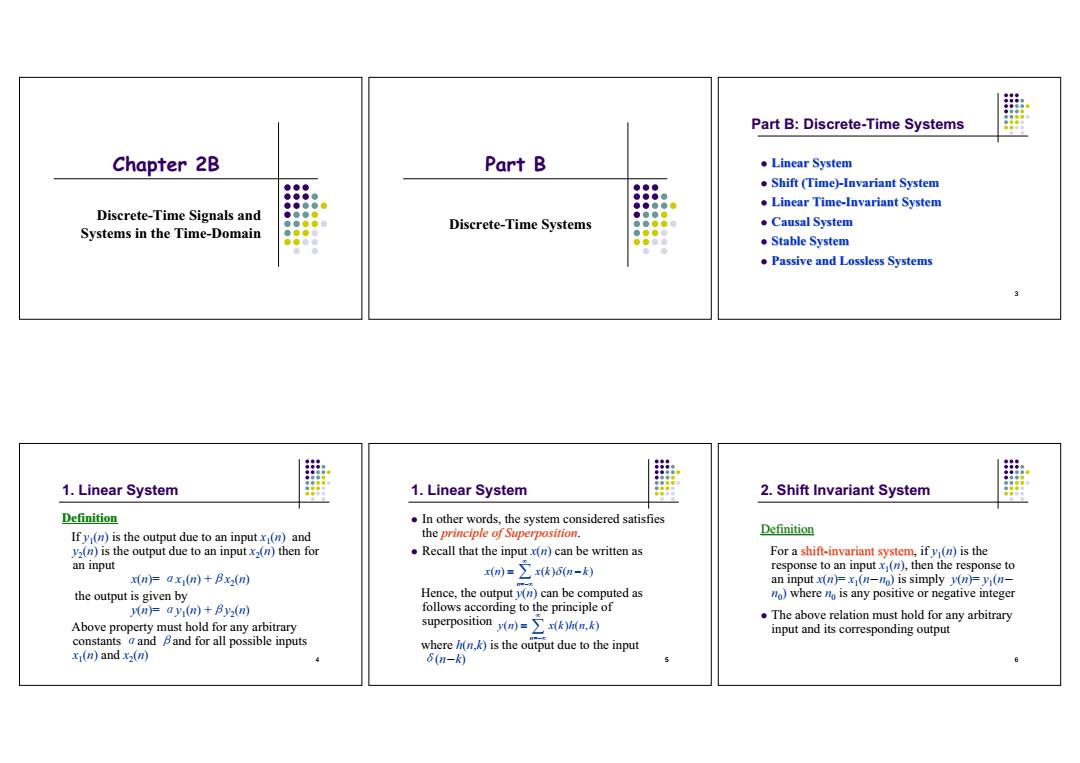正在加载图片...

Part B:Discrete-Time Systems Chapter 2B Part B ·Linear System ●●● ●●● Shift(Time)-Invariant System ●●●南 Linear Time-Invariant System Discrete-Time Signals and Discrete-Time Systems 。Causal System Systems in the Time-Domain Stable System Passive and Lossless Systems 1.Linear System 1.Linear System 2.Shift Invariant System Definition In other words,the system considered satisfies Ify (n)is the output due to an inputx (n)and the principle of Superposition. Definition y2(n)is the output due to an inputx(n)then for Recall that the inputx(n)can be written as For a shift-invariant system,if y(n)is the an input m=立k)6a- response to an input x(n),then the response to x(n)=ax (n)+Bx2(n) an input x(n)=x(n-mo)is simply y(n)=y(n- the output is given by Hence,the output n)can be computed as no)where no is any positive or negative integer y(n)=ay (n)+By2(n) follows according to the principle of superposition y(m)=(n) The above relation must hold for any arbitrary Above property must hold for any arbitrary input and its corresponding output constants a andand for all possible inputs where h(n,k)is the output due to the input x(n)and x2(m) 4 6(n-k3Chapter 2B Discrete-Time Signals and Systems in the Time-Domain Part B Discrete-Time Systems 3 Part B: Discrete-Time Systems Linear System Shift (Time) Shift (Time)-Invariant System Linear Time Linear Time-Invariant System Causal System Stable System Passive and Lossless Systems Passive and Lossless Systems 4 1. Linear System Definition If y1(n) is the output due to an input x1(n) and y2(n) is the output due to an input x2(n) then for an input x(n)= ¢x1(n) +£x2(n) the output is given by y(n)= ¢y1(n) +£y2(n) Above property must hold for any arbitrary constants ¢and £and for all possible inputs x1(n) and x2(n) 5 1. Linear System In other words, the system considered satisfies the principle of Superposition. Recall that the input x(n) can be written as Hence, the output y(n) can be computed as follows according to the principle of superposition where h(n,k) is the output due to the input ¥(nˉk) () ()( ) n xn xk n k () ()(, ) n yn xkhnk 6 2. Shift Invariant System Definition For a shift-invariant system, if y1(n) is the response to an input x1(n), then the response to an input x(n)= x1(nˉn0) is simply y(n)= y1(nˉ n0) where n0 is any positive or negative integer The above relation must hold for any arbitrary input and its corresponding output��������������